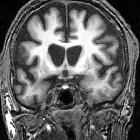pantothenate kinase-associated neurodegeneration





Pantothenate kinase-associated neurodegeneration (PKAN), historically also known as Hallervorden-Spatz syndrome, is an autosomal recessive disorder causing involuntary spasticity and progressive dementia. It is a subset of neurodegeneration with brain iron accumulation (NBIA).
Epidemiology
Classical PKAN tends to have onset before 6 years of age, whereas atypical PKAN manifests at a mean age of 14 years . Prevalence is estimated around 1-3 per million .
Clinical presentation
Described features include :
- progressive dementia
- extrapyramidal signs (rigidity, dystonia, choreoathetosis)
- corticospinal signs (spasticity, hyperreflexia)
- dysarthria
- retinitis pigmentosa
- tremors
The clinical course is usually relentlessly progressive with affected individuals dying in their second or third decade.
The diagnosis is made by a combination of clinical and imaging features, however, genetic testing and full gene sequencing of the PANK2 gene to identify biallelic PANK2 pathogenic variants is considered the gold standard .
Radiographic features
Reflects areas of iron deposition, mainly in the globi pallidi, substantia nigra, and red nuclei.
CT
CT is of limited utility but often shows calcification the globi pallidi which, however, is non-specific and has a long differential (basal ganglia calcification) .
MRI
- T2: T2-weighted MRI images often demonstrate hypointense changes in the globus pallidi and pars reticulata of the substantia nigra
- SWI/T2*: shows susceptibility artifact (low signal) in corresponding areas from iron deposition
Cortex is usually spared but caudate atrophy may be seen in more advanced cases. The eye of the tiger sign refers to a central T2 relatively hyperintense spot (line) within the hypointense globi pallidi due to gliosis and vacuolisation .
MR spectroscopy
- shows decreased NAA peak due to neuronal loss and may show increased myoinositol
History and etymology
The condition was previously named after two 20 century German neuropathologists Julius Hallervorden (1882-1965) and, his superior, Hugo Spatz (1888-1969)
Julius Hallervorden personally examined 697 brains from disabled adults and children who had been murdered as part of the Nazi euthanasia program at the Kaiser-Wilhelm-Institut für Hirnforschung in Berlin-Buch. Hugo Spatz, was Director of this division. Thus the alternate name of the condition - pantothenate kinase-associated neurodegeneration - is now preferred by contemporaneous authors .
Siehe auch:
- Globus pallidus
- substantia nigra
- Demyelinisierende Erkrankung
- eye of tiger sign
- Chorea Huntington
- Nucleus caudatus
- Retinitis pigmentosa
- infantile Neuroaxonale Dystrophie
- SENDA syndrome
und weiter:

 Assoziationen und Differentialdiagnosen zu Neurodegeneration mit Eisenablagerung im Gehirn:
Assoziationen und Differentialdiagnosen zu Neurodegeneration mit Eisenablagerung im Gehirn:




